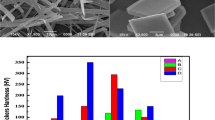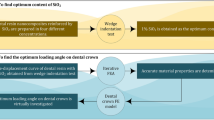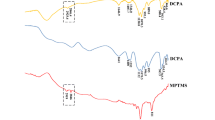Abstract
Dental resin-based composites have been used for more than 50 years. The size and the structure of inorganic filler have a great effect on the mechanical properties of the composite resin. In this study, novel micro-sized clusters of hydroxyapatite nanorods (MCHN) were designed and conveniently fabricated by spray drying combined with heat treatment. The effects of the aspect ratio of primary hydroxyapatite nanorods (HN), suspension concentration for spray drying and heat treatment temperature were explored. The results indicated that HN with a lower aspect ratio of 2 (HN-2) and a heat treatment temperature of 500 °C were beneficial to the construction of high-performance MCHN (MCHN-2). As compared to HN-2, MCHN-2 had a further increased filling amount by 10%. More importantly, the flexural strength, flexural modulus and compressive strength of the composite resin were greatly improved by 36.3%, 11.4% and 56.6%, respectively. Therefore, it could be envisioned that MCHN could have a great potential in dental restorative application.












Similar content being viewed by others
References
Qi C, Lin J, Fu LH, Huang P (2018) Calcium-based biomaterials for diagnosis, treatment, and theranostics. Chem Soc Rev 47:357–403
Lv SS, Dudek DM, Cao Y, Balamurali MM, Gosline J, Li HB (2010) Designed biomaterials to mimic the mechanical properties of muscles. Nature 465:69–73
Wang D, Wang ZY, Zhan QQ, Pu Y, Wang JX, Foster NR, Dai LM (2017) Facile and scalable preparation of fluorescent carbon dots for multifunctional applications. Engineering 3:402–408
Duraccio D, Mussano F, Faga MG (2015) Biomaterials for dental implants: current and future trends. J Mater Sci 50:4779–4812. https://doi.org/10.1007/s10853-015-9056-3
Volpe JJ (2009) Brain injury in premature infants: a complex amalgam of destructive and developmental disturbances. Lancet Neurol 8:110–124
Habib E, Wang RL, Wang YZ, Zhu MF, Zhu XX (2016) Inorganic fillers for dental resin composites: present and future. ACS Biomater Sci Eng 2:1–11
Miao XL, Li YG, Zhang QH, Zhu MF, Wang HZ (2012) Low shrinkage light curable dental nanocomposites using SiO2 microspheres as fillers. Mater Sci Eng, C 32:2115–2121
Habib E, Wang RL, Zhu XX (2018) Correlation of resin viscosity and monomer conversion to filler particle size in dental composites. Dent Mater 34:1501–1508
Karabela MM, Sideridou ID (2011) Synthesis and study of properties of dental resin composites with different nanosilica particles size. Dent Mater 27:825–835
Liu FW, Sun B, Jiang XZ, Aldeyab SS, Zhang QH, Zhu MF (2016) Mechanical properties of dental resin/composite containing urchin-like hydroxyapatite. Dent Mater 30:358–368
Kaizer MR, de Oliveira-Ogliaria A, Cenci MS, Opdam NJ, Moraes RR (2014) Do nanofill or submicron composites show improved smoothness and gloss? A systematic review of in vitro studies. Dent Mater 30:e41–e78
Robertson CG, Lin CJ, Rackaitis M, Roland CM (2008) Influence of particle size and polymer-filler coupling on viscoelastic glass transition of particle-reinforced polymers. Macromolecules 41:2727–2731
Valente LL, Peraltaa SL, Ogliarib FA, Cavalcantec LM, Moraesa RR (2013) Comparative evaluation of dental resin composites based on micron- and submicron-sized monomodal glass filler particles. Dent Mater 29:1182–1187
Ferracane JL (2016) Current trends in dental composites. Crit Rev Oral Biol Med 6:302–318
Attik N, Hallay F, Bois L, Brioude A, Grosgogeat B, Colon P (2017) Mesoporous silica fillers and resin composition effect on dental composites cytocompatibility. Dent Mater 33:166–174
Habib E, Wang RL, Zhu XX (2017) Monodisperse silica-filled composite restoratives mechanical and light transmission properties. Dent Mater 33:280–287
Ferracane JL (2011) Resin composite-State of the art. Dent Mater 27:29–38
Turssi CP, Ferracane JL, Vogel K (2005) Filler features and their effects on wear and degree of conversion of particulate dental resin composites. Biomaterials 26:4932–4937
Cavalcante LM, Masouras K, Watts DC, Pimenta LA, Silikas N (2009) Effect of nanofillers’ size on surface properties after toothbrush abrasion. Am J Dent 22:60–64
Nagarajan VS, Jahanmir S, Thompson VP (2004) In vitro contact wear of dental composites. Dent Mater 20:63–71
Lee JH, Um CM, Lee IB (2006) Rheological properties of resin composites according to variations in monomer and filler composition. Dent Mater 22:515–526
Hu X, Gong J, Zhang L, Yu JC (2008) Continuous size tuning of monodisperse ZnO colloidal nanocrystal clusters by a microwave-polyol process and their application for humidity sensing. Adv Mater 20:4845–4850
Wang RL, Habib E, Zhu XX (2018) Evaluation of the filler packing structures in dental resin composites: from theory to practice. Dent Mater 34:1014–1023
Mitra SB, Wu D, Holmes BN (2003) An application of nanotechnology in advanced dental materials. J Am Dent Assoc 134:1382–1390
Atai M, Pahlavan A, Moin N (2012) Nano-porous thermally sintered nano silica as novel fillers for dental composites. Dent Mater 28:133–145
Wang RL, Bao S, Liu FW, Jiang XZ, Zhang QH, Sun B, Zhu MF (2013) Wear behavior of light-cured resin composites with bimodal silica nanostructures as fillers. Mater Sci Eng, C 33:4759–4766
Wang RL, Zhang ML, Liu FW, Bao S, Wu TT, Jiang XZ, Zhang QH, Zhu MF (2015) Investigation on the physical-mechanical properties of dental resin composites reinforced with novel bimodal silica nanostructures. Mater Sci Eng, C 50:266–273
Lenji RK, Nourbakhsh AA, Nourbakhsh N, Nourbakhsh M, Mackenzie KJD (2017) Phase formation, microstructure and setting time of MCM-48 mesoporous silica nanocomposites with hydroxyapatite for dental applications: effect of the Ca/P ratio. Ceram Int 43:12857–12862
Saen P, Atai M, Nodehi A, Solhi L (2016) Physical characterization of unfilled and nanofilled dental resins: static versus dynamic mechanical properties. Dent Mater 32:185–197
Thorat SB, Diaspro A, Salerno M (2013) Effect of alumina reinforcing fillers in BisGMA-based resin composites for dental applications. Adv Mater Lett 4:15–21
Yoshida K, Tanagawa M, Atsuta M (2001) Effects of filler composition and surface treatment on the characteristics of opaque resin composites. J Biomed Mater Res 58:525–530
Thorat SB, Patra N, Ruffilli R, Diaspro A, Salerno M (2012) Preparation and characterization of a BisGMA-resin dental restorative composites with glass, silica and titania fillers. Dent Mater 31:635–644
Liu FW, Jiang XZ, Zhang QH, Zhu MF (2014) Strong and bioactive dental resin composite containing poly(Bis-GMA) grafted hydroxyapatite whiskers and silica nanoparticles. Compos Sci Technol 101:86–93
Suchanek K, Bartkowiak A, Gdowik A, Perzanowski M, Kąc S, Szaraniec B, Suchanek M, Marszałeka M (2015) Crystalline hydroxyapatite coatings synthesized under hydrothermal conditions on modified titanium substrates. Mater Sci Eng C Mater Biol Appl 51:57–63
Singh B, Tandon A, Pandey AK, Singh P (2018) Enhanced dielectric constant and structural transformation in Fe-doped hydroxyapatite synthesized by wet chemical method. J Mater Sci 53:8807–8816. https://doi.org/10.1007/s10853-018-2225-4
Andrade Neto DM, Carvalho EV, Rodrigues EA, Feitosa VP, Sauro S, Mele G, Carbone L, Mazzetto SE, Rodrigues LK, Fechine PBA (2016) Novel hydroxyapatite nanorods improve anti-caries efficacy of enamel infiltrants. Dent Mater 32:784–793
Liu FW, Bao S, Jin Y, Jiang XZ, Zhu MF (2014) Novel bionic dental resin composite reinforced by hydroxyapatite whisker. Mater Res Innov 18:854–858
Zhang H, Darvell BW (2012) Mechanical properties of hydroxyapatite whisker-reinforced bis-GMA-based resin composites. Dent Mater 28:824–830
Chen L, Yu QS, Wang Y, Li H (2011) BisGMA/TEGDMA dental composite containing high aspect-ratio hydroxyapatite nanofibers. Dent Mater 27:1187–1195
Liu FW, Wang RL, Cheng YH, Jiang XZ, Zhang QH, Zhu MF (2013) Polymer grafted hydroxyapatite whisker as a filler for dental composite resin with enhanced physical and mechanical properties. Mater Sci Eng, C 33:4994–5000
Waldron K, Wu WD, Wu ZX, Liu WJ, Selomulya C, Zhao DY, Chen XD (2014) Formation of monodisperse mesoporous silica microparticles via spray-drying. J Colloid Interface Sci 418:225–233
Cheow WS, Li S, Hadinoto K (2010) Spray drying formulation of hollow spherical aggregates of silica nanoparticles by experimental design. Chem Eng Res Des 88:673–685
Lee SY, Gradon L, Janeczko S, Iskandar F, Okuyama K (2010) Formation of highly ordered nanostructures by drying micrometer colloidal droplets. ACS Nano 4:4717–4724
Okuyama K, Abdullah M, Lenggoro IW, Iskandar F (2006) Preparation of functional nanostructured particles by spray drying. Adv Powder Technol 17:587–611
Lv BY, Zhao LS, Pu Y, Le Y, Zeng XF, Chen JF, Wen N, Wang JX (2017) Facile preparation of controllable-aspect-ratio hydroxyapatite nanorods with high-gravity technology for bone tissue engineering. Ind Eng Chem Res 56:2976–2983
Cao JM, Feng J, Deng SG, Chang X, Wang J, Liu JS, Lu P, Lu HX, Zheng MB, Zhang F, Tao J (2005) Microwave-assisted solid-state synthesis of hydroxyapatite nanorods at room temperature. J Mater Sci 40:6311–6313. https://doi.org/10.1007/s10853-005-4221-8
Sideridou ID, Karabela MM (2009) Effect of the amount of 3-methacyloxypropyltrimethoxysilane coupling agent on physical properties of dental resin nanocomposites. Dent Mater 25:1315–1324
Curtis AR, Palin WM, Fleming GJP, Shortall ACC, Marquis PM (2009) The mechanical properties of nanofilled resin-based composites: the impact of dry and wet cyclic pre-loading on bi-axial flexure strength. Dent Mater 25:188–197
Halvorsona RH, Ericksona RL, Davidsonb CL (2003) The effect of filler and silane content on conversion of resin-based composite. Dent Mater 19:327–333
Sadat-Shojai M, Atai M, Nodehi A, Khanlar LN (2010) Hydroxyapatite nanorods as novel fillers for improving the properties of dental adhesives: synthesis and application. Dent Mater 26:471–482
Salehi S, Gwinner F, Mitchell JC, Pfeifer C, Ferracane JL (2015) Cytotoxicity of resin composites containing bioactive glass fillers. Dent Mater 31:195–203
Goncalves F, Azevedo CL, Ferracane JL, Braga RR (2011) BisGMA/TEGDMA ratio and filler content effects on shrinkage stress. Dent Mater 27:520–526
Wang ZZ, Landis FA, Giuseppettic AAM, Gibsona SL, Chianga MYM (2014) Simultaneous measurement of polymerization stress and curing kinetics for photo-polymerized composites with high filler contents. Dent Mater 30:1316–1324
Lööfa J, Svahn F, Jarmar T, Engqvist H, Pameijer CH (2008) A comparative study of the bioactivity of three materials for dental applications. Dent Mater 24:653–659
Yan SF, Yin JB, Cui L, Yang Y, Chen XS (2011) Apatite-forming ability of bioactive poly(l-lactic acid)/grafted silica nanocomposites in simulated body fluid. Colloids Surf B 86:218–224
Acknowledgements
This work was financially supported by the National Key Research and Development Program of China (2016YFA0201701/2016YFA0201700), National Natural Science Foundation of China (21878015 and 21622601) and National Key Basic Research Program of China (2015CB932100).
Author information
Authors and Affiliations
Corresponding authors
Rights and permissions
About this article
Cite this article
Zhao, SN., Yang, DL., Wang, D. et al. Design and efficient fabrication of micro-sized clusters of hydroxyapatite nanorods for dental resin composites. J Mater Sci 54, 3878–3892 (2019). https://doi.org/10.1007/s10853-018-3125-3
Received:
Accepted:
Published:
Issue Date:
DOI: https://doi.org/10.1007/s10853-018-3125-3




